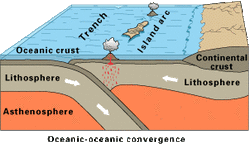Convergent Boundaries

A convergent boundary is a type of boundary where two plates meet together and start to push against one another. There are three types of convergent boundaries each with its own consequences.
Oceanic-Continental Convergence
The first type of convergent boundary is Oceanic-Continetal Convergence. This type of convergent boundary happens where an oceanic plate and a continental plate push together causing the oceanic plate to be forced under the continental plate into the mantle because the oceanic plate is thinner. This is called a subduction. When the oceanic plate is pushed under, it melts and turns into hot magma which burns its way through the continental plate, creating a volcano and causing many earthquakes.
Oceanic-Oceanic Convergence
The next type is Oceanic-Oceanic Convergence. This type of convergent boundary happens where two oceanic plates push against one another, causing the colder, denser, older plate to buckle up and sink into the mantle. Hot magma comes from where the plate sank, creating new crust.
Continental-Continental Convergence
The final type of convergent boundary is Continental-Continental Convergence. This type of boundary happens where two continental plates collide and push up creating mountain ranges. Like colliding icebergs resist downward motion, the same thing happens with colliding continental plates, instead of moving down, they move up.
